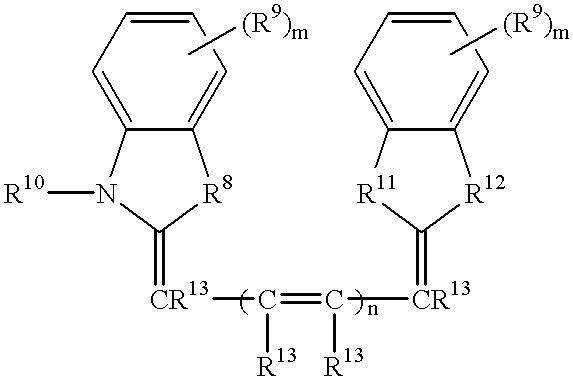Labeled peptides, proteins and antibodies and processes and intermediates useful for their preparation
a technology of peptides and proteins, applied in the field of process and intermediates useful for their preparation, can solve the problems of difficult limiting their general use, and requiring the synthesis of dye constructs or amino acids that are difficult to make, and achieves high efficiency
- Summary
- Abstract
- Description
- Claims
- Application Information
AI Technical Summary
Benefits of technology
Problems solved by technology
Method used
Image
Examples
example 1
Site-specific Labeling of a Secondary Aminooxy Group
[0163]Under controlled pH conditions, the low pKa and enhanced nucleophilicity of an aminooxy group relative to other nucleophilic side chains found in peptides suggested the possibility of site-specific reaction with standard electrophiles such as succimidyl esters (FIG. 1). While selective labeling of a primary aminooxy group in the context of an unprotected peptide was achieved, extensive attempts to utilize the primary aminooxy group during synthesis failed. Even when protected as the 2-Chlorobenzyloxycarbonyl carbamate, deprotonation of the primary aminooxy group allowed rapid acylation, so it could not be readily incorporated during peptide synthesis. Thus, under certain conditions, the use of a secondary aminooxy group may be preferred.
[0164]A test peptide containing both a secondary aminooxy group and nucleophilic amino acids that were most likely to interfere with selective labeling at the aminooxy nitrogen (lysine, cystei...
example 2
The Secondary Aminooxy Group is Compatible with Cα-thioesters and Amide-forming Ligation.
[0172]Preparation of proteins by total chemical synthesis often requires the ligation of large polypeptides prepared by solid-phase peptide synthesis on thioester-linker resins. The most generally applicable methods available for ligations are native chemical ligation and expressed protein ligation. These processes utilize the same basic chemistry to join two peptides, one with an N-terminal cysteine and the other with a C-terminal thioester, through a regiospecific and site-specific reaction to generate a larger polypeptide. The application of aminooxy-labeling chemistry to the synthesis of large polypeptides and proteins requires compatibility with these solid-phase peptide synthesis and ligation chemistries.
[0173]The optimal approach for utilizing aminooxy-labeling chemistry in the chemical synthesis of proteins is direct incorporation of the aminooxy group as part of an amino acid used durin...
example 3
Specificity of Labeling in Protein Domains Containing Aminooxy Amino Acids.
[0177]As a control to establish the selectivity of labeling for aminooxy amino acid, the labeling of native β-Lactoglobulin with tetramethylrhodamine N-hydroxysuccinimide ester was attempted. It was found that non-specific labeling of this 162 aa protein containing 15 lysines and 4 cysteines was minimal (<1%), even after 6 hours.
[0178]Finally, the GTPase binding domain of p21 activated kinase (45 aa, 4 lys, 1 cys) with a secondary aminooxy amino acid incorporated at the amino-terminus (SAOD-PBD) was prepared. Previous experiments have demonstrated that PBD domains labeled with fluorescent reporter dyes at this terminus could be used as biosensors of GTPase activation. Labeling of PBD using the new methodology would enable the production of sufficient quantities to apply the biosensors in vivo and in pharmaceutical screening applications, and would allow incorporation of sensitive detectable groups enabling ap...
PUM
| Property | Measurement | Unit |
|---|---|---|
| Fraction | aaaaa | aaaaa |
| Fraction | aaaaa | aaaaa |
| Acidity | aaaaa | aaaaa |
Abstract
Description
Claims
Application Information
 Login to View More
Login to View More - R&D
- Intellectual Property
- Life Sciences
- Materials
- Tech Scout
- Unparalleled Data Quality
- Higher Quality Content
- 60% Fewer Hallucinations
Browse by: Latest US Patents, China's latest patents, Technical Efficacy Thesaurus, Application Domain, Technology Topic, Popular Technical Reports.
© 2025 PatSnap. All rights reserved.Legal|Privacy policy|Modern Slavery Act Transparency Statement|Sitemap|About US| Contact US: help@patsnap.com



